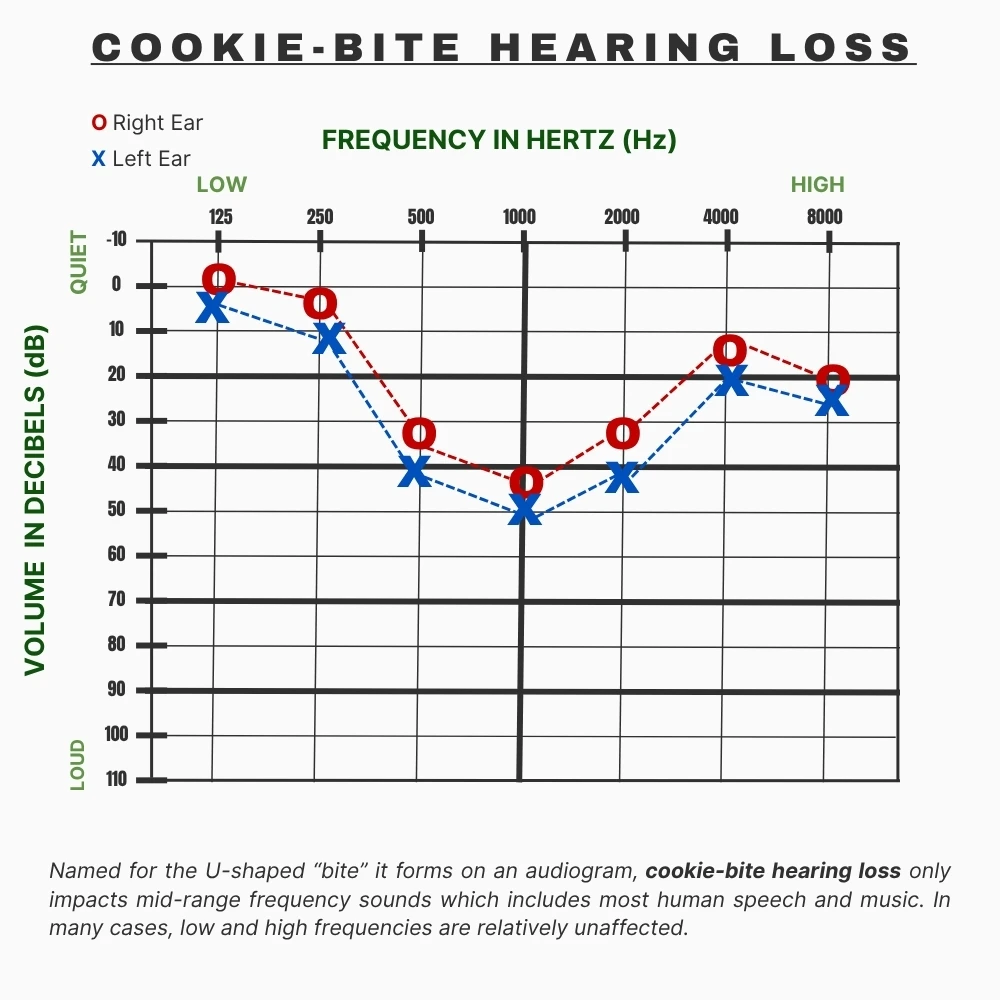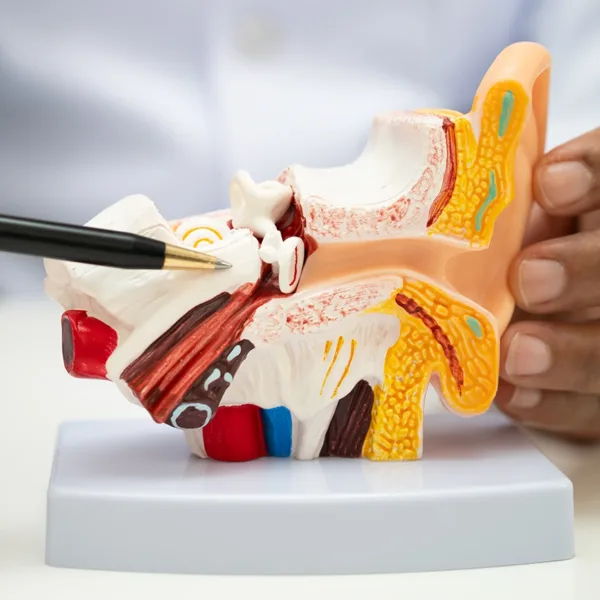
Imagine listening to a conversation, but it feels like parts of words are missing, or listening to music, but the melody sounds thin or unbalanced. The high- and low-pitched sounds remain clear, but overall, things sound muffled and incomplete. This is the reality for many people with cookie-bite hearing loss, a rare condition that only affects about 0.7% of the population.1
Cookie-bite hearing loss makes it difficult to hear mid-range frequency sounds, which are crucial for understanding speech and many other everyday sounds. In this guide, we provide a detailed overview of what cookie bite hearing loss is, including common symptoms, causes, and treatment options.
Jump Ahead:
What Is Cookie-Bite Hearing Loss? (Mid-Range Frequency Hearing Loss)
Cookie-bite hearing loss, also known as mid-range frequency hearing loss, is a type of sensorineural hearing loss (SNHL). This means it’s caused by problems relating to the auditory nerve, and/or the microscopic hair cells located in the inner ear (cochlea).

Named for the U-shaped “bite” it forms on an audiogram, this rare condition only impacts mid-range frequency sounds, which includes most human speech and music. In many cases, low and high frequencies are relatively unaffected.
An audiogram graph is the results of a professional hearing test, which maps how well an individual can hear different frequencies. If the graph results are shaped like a “U” (resembling a bite taken out of a cookie), it represents mid-range frequency hearing loss.
Sound Frequency Ranges: Low, Mid, and High
Sound frequencies are typically divided into three main ranges: low, mid, and high. The frequency of a sound correlates with its pitch. Frequency is measured in Hertz (Hz). The higher the Hertz, the higher the frequency, and thus the higher the pitch of a sound.
Below are some examples of common sounds in each frequency range:
Low-Range Frequency Sounds (20–500 Hz):
- Subwoofers
- Bass drums
- Lion’s roar
- Thunder rumbling
- Bass guitars
Mid-Range Frequency Sounds (500-2,000 Hz):
- Most human speech (vowels and mid-range consonants)
- Motorcycles
- Violin music
- Vacuum cleaners
- Old-fashioned telephone ringing
High-Range Frequency Sounds (2,000-8,000+ Hz):
- High range speech consonants (‘s,’ ‘f,’ ‘th’)
- Smoke alarms
- Birds and crickets chirping
- Flute and piccolo music
- High-pitch voices (women and children)
An adult with healthy hearing can typically hear frequencies within all three frequency ranges between 20–20,000 Hz. A person with cookie bite hearing loss typically struggles to hear mid-range frequency sounds between 500–2,000 Hz.
Symptoms of Cookie-Bite Hearing Loss
Symptoms of cookie-bite hearing loss primarily involve difficulty hearing mid-range frequency sounds, which includes most speech and music. Even if mid-frequency sounds are at a detectable volume, they are typically unclear or difficult to understand.
Common symptoms of cookie-bite hearing loss include:
- Difficulty understanding speech, especially when several people are talking or in noisy environments
- Struggling to hear speech clarity rather than loudness—voices may be audible but lack sharpness or fullness
- Feeling like people mumble or that voices sound muted or unclear, even when they seem to be speaking loud enough
- TV and movie dialogue is difficult to follow, even when the volume is turned up
- Telephone calls are hard to hear, and people on the other end of the line often sound muffled, distant, or unclear
- Trouble hearing the “middle” sounds of words, making it hard to follow conversations
- Missing parts of music or melodies, especially mid-range instruments or vocals
If you or a loved one is experiencing any of these symptoms, it’s important to schedule a hearing exam as soon as possible to identify the cause and receive timely treatment.
Causes of Cookie Bite Hearing Loss
Cookie-bite hearing loss is almost always caused by genetic factors. Hereditary hearing loss is the result of genetic mutations passed from parent to child. Even if both parents show no symptoms, it’s still possible for them to be carriers and pass a mutation on.
Cookie-bite hearing loss may be present at birth or progress over time. In very rare cases, the condition can be caused by a benign tumor instead of genetic factors. Below, we take a closer look at potential causes of cookie-bite hearing loss and the unique ways it can affect everyday hearing:
Congenital Factors
Cookie-bite hearing loss is often congenital, which means it’s present at birth. The most common cause is a mutation in the TECTA gene.2 TECTA is essential for the development of the tectorial membrane (TM), a part of the ear that helps the brain interpret sound waves. TM malfunctions can make it more challenging to hear mid-range frequency sounds, resulting in cookie-bite hearing loss.3
In some cases, cookie bite hearing loss may not become noticeable until adolescence or adulthood, as it often progresses slowly over time. Because both low- and high-frequency hearing remain relatively normal, people with this genetic condition may not realize they’re missing certain sounds until speech clarity becomes noticeably reduced later on in life.
However, early intervention is essential to ensure the development of proper communication skills. Experts recommend that newborns receive hearing tests no later than 1 month after birth.4
Progressive Factors
While genetics is the leading cause of cookie-bite hearing loss, certain progressive factors can influence how the condition develops or worsens over time. In some cases, age-related hearing loss (presbycusis) may overlap with an existing genetic condition. Although presbycusis typically affects high-frequency sounds first, it can gradually extend into the mid-frequency range, further reducing speech clarity.
Other factors that can contribute to the progression of hearing loss include:
- Exposure to loud noise: Excessive exposure to loud sounds can damage vital ear cells and cause noise-induced hearing loss (NIHL).
- Ototoxic medications: Some medications have a toxic effect on the ear, which can cause hearing loss.
- Smoking cigarettes: The chemicals found in cigarettes can cause chronic inflammation that damages hearing.
- Underlying health conditions: Underlying conditions like diabetes, high blood pressure, or infections can speed up the progression of hearing loss.
Together, these progressive factors may not directly cause cookie-bite hearing loss, but they can accelerate its progression or increase its impact on daily quality of life.
Acoustic Neuroma Tumor (Rare)
In very rare cases, cookie-bite hearing loss is the result of an acoustic neuroma (vestibular schwannoma). This is a benign tumor that can compress against the auditory nerve, causing conductive hearing loss. About 90% of all acoustic neuroma cases involve hearing loss.5
In some cases, surgically removing the acoustic neuroma can reverse symptoms. However, if it causes permanent nerve damage, some people may still experience hearing loss even after the tumor is gone.
Cookie Bite Hearing Loss Treatment Options
Although cookie-bite hearing loss cannot be reversed, there are treatment options that can greatly improve hearing clarity and overall quality of life. This type of hearing loss affects the mid-range frequencies where most speech and everyday sounds occur. So, treatment generally focuses on amplifying and balancing those frequencies without over-amplifying sounds that are already heard well.
This is why prescription hearing aids are the most common and effective treatment for cookie bite hearing loss. Today’s prescription devices can be precisely programmed to target mid-frequency hearing loss, restoring clarity and delivering a more natural listening experience. Advanced models featuring artificial intelligence (AI) automatically adjust to different listening environments, enhance speech, and reduce background noise to make conversations easier and more comfortable.
If you’re struggling to follow conversations or notice that speech sounds muffled, schedule a comprehensive hearing exam as soon as possible. With today’s advanced hearing technology, it’s possible to rediscover the full, balanced sound of everyday life.
Schedule a Hearing Exam at an Audibel Clinic Near You
Cookie-bite hearing loss is a rare type of hearing loss that only affects mid-range frequency noises, crucial for understanding speech and many other everyday sounds. If you suspect you might have cookie-bite hearing loss, don’t wait to get care.
At Audibel, our hearing specialists are dedicated to helping you find the best hearing loss solutions for your needs, lifestyle, and budget. Find an Audibel clinic near you to explore your options and take the next step toward better hearing.
References
- Birkenbeuel, J., Abouzari, M., Goshtasbi, K., Moshtaghi, O., Sahyouni, R., Moshtaghi, A., Cheung, D., Gelnett, D., Lin, H. W., & Djalilian, H. R. (2019). Characteristics of Mid-Frequency sensorineural hearing loss progression. Otology & Neurotology, 40(5), e497–e502. https://doi.org/10.1097/mao.0000000000002232
- Yamamoto, N., Mutai, H., Namba, K., Morita, N., Masuda, S., Nishi, Y., Nakano, A., Masuda, S., Fujioka, M., Kaga, K., Ogawa, K., & Matsunaga, T. (2017). Prevalence of TECTA mutation in patients with mid-frequency sensorineural hearing loss. Orphanet Journal of Rare Diseases, 12(1). https://doi.org/10.1186/s13023-017-0708-z
- Sellon, J. B., Ghaffari, R., & Freeman, D. M. (2018b). The Tectorial Membrane: mechanical properties and functions. Cold Spring Harbor Perspectives in Medicine, 9(10), a033514. https://doi.org/10.1101/cshperspect.a033514
- Your baby’s hearing screening and next steps. (2024, June 10). NIDCD. https://www.nidcd.nih.gov/health/your-babys-hearing-screening-and-next-steps?_gl=1*rtxbdt*_gcl_au*MTA3MjM1NDQ2My4xNzUzMzczNDUz
- Acoustic neuroma (Vestibular schwannoma). (2023, March 6). Johns Hopkins Medicine. https://www.hopkinsmedicine.org/health/conditions-and-diseases/brain-tumor/vestibular-schwannoma







Have a question or Comment?